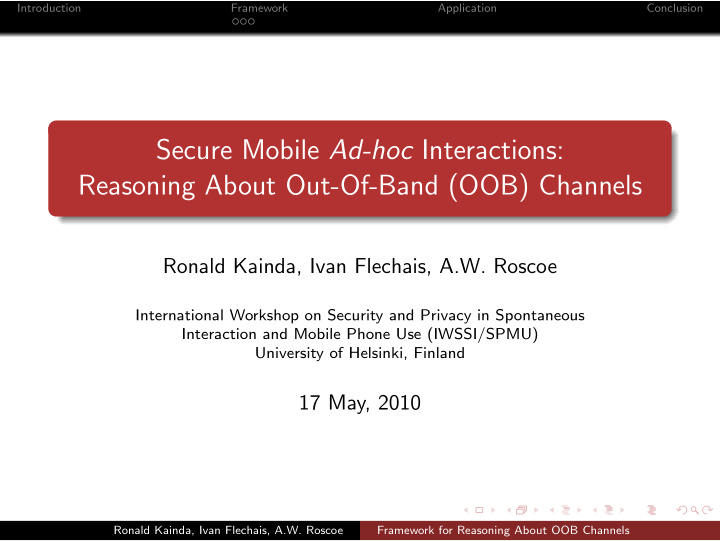



Introduction Framework Application Conclusion Secure Mobile Ad-hoc Interactions: Reasoning About Out-Of-Band (OOB) Channels Ronald Kainda, Ivan Flechais, A.W. Roscoe International Workshop on Security and Privacy in Spontaneous Interaction and Mobile Phone Use (IWSSI/SPMU) University of Helsinki, Finland 17 May, 2010 Ronald Kainda, Ivan Flechais, A.W. Roscoe Framework for Reasoning About OOB Channels
Introduction Framework Application Conclusion Outline Introduction 1 Framework 2 Technical and contextual factors Human factors OOB Channels Application 3 Conclusion 4 Ronald Kainda, Ivan Flechais, A.W. Roscoe Framework for Reasoning About OOB Channels
Introduction Framework Application Conclusion Human-Interactive Security Protocols OOB N OOB = Out-Of-Band Channel, N = Normal Channel Ronald Kainda, Ivan Flechais, A.W. Roscoe Framework for Reasoning About OOB Channels
Introduction Framework Application Conclusion Limitations of existing OOB channels User interfaces Device specific Similar devices Universal solution Scenario specific Ronald Kainda, Ivan Flechais, A.W. Roscoe Framework for Reasoning About OOB Channels
Introduction Framework Application Conclusion OOB channels - factors to consider Ronald Kainda, Ivan Flechais, A.W. Roscoe Framework for Reasoning About OOB Channels
Introduction Framework Application Conclusion OOB channels - factors to consider Ronald Kainda, Ivan Flechais, A.W. Roscoe Framework for Reasoning About OOB Channels
Introduction Framework Application Conclusion OOB channels - factors to consider Ronald Kainda, Ivan Flechais, A.W. Roscoe Framework for Reasoning About OOB Channels
Introduction Framework Application Conclusion OOB channels - factors to consider Ronald Kainda, Ivan Flechais, A.W. Roscoe Framework for Reasoning About OOB Channels
Introduction Framework Application Conclusion Technical and contextual factors Contextual Social, physical, technological etc. Matching needs to immediate security concerns Changing context is a challenge Ronald Kainda, Ivan Flechais, A.W. Roscoe Framework for Reasoning About OOB Channels
Introduction Framework Application Conclusion Technical and contextual factors Contextual Social, physical, technological etc. Matching needs to immediate security concerns Changing context is a challenge Technical Vulnerable to non-malicious users Complexity is bad for security Require technical expertise Security = technical solution + correct application within context Ronald Kainda, Ivan Flechais, A.W. Roscoe Framework for Reasoning About OOB Channels
Introduction Framework Application Conclusion Human factors Personal variables Aware of security needs, unmotivated Users misconceive risk Social countermeasure Are vulnerable to lapses (human error?) Ronald Kainda, Ivan Flechais, A.W. Roscoe Framework for Reasoning About OOB Channels
Introduction Framework Application Conclusion Human factors Personal variables Aware of security needs, unmotivated Users misconceive risk Social countermeasure Are vulnerable to lapses (human error?) Intentions Willingness to carry out a particular behaviour Attitude (beliefs) and motivation Security must be aligned with user goals Ronald Kainda, Ivan Flechais, A.W. Roscoe Framework for Reasoning About OOB Channels
Introduction Framework Application Conclusion Human factors Personal variables Aware of security needs, unmotivated Users misconceive risk Social countermeasure Are vulnerable to lapses (human error?) Intentions Willingness to carry out a particular behaviour Attitude (beliefs) and motivation Security must be aligned with user goals Capability Perception Physical, mental, technological Ronald Kainda, Ivan Flechais, A.W. Roscoe Framework for Reasoning About OOB Channels
Introduction Framework Application Conclusion OOB channels Target goals Secure Scalable Adaptation Fit for purpose Ronald Kainda, Ivan Flechais, A.W. Roscoe Framework for Reasoning About OOB Channels
Introduction Framework Application Conclusion Application of framework Application Fits in User-Centred Design (UCD) process Analysis, design, evaluate Evaluation may be against theoretical specifications or empirical Outcome of evaluation used as feedback Ronald Kainda, Ivan Flechais, A.W. Roscoe Framework for Reasoning About OOB Channels
Introduction Framework Application Conclusion Summary and conclusion Summary Proposed methods limited in application OOB channels must be evaluated against technical security requirements, human factors, and context Proposed framework identifies main elements Framework fits into UCD process Possibility of extending to other secure systems Ronald Kainda, Ivan Flechais, A.W. Roscoe Framework for Reasoning About OOB Channels
Introduction Framework Application Conclusion THANK YOU Ronald Kainda, Ivan Flechais, A.W. Roscoe Framework for Reasoning About OOB Channels
Recommend
More recommend